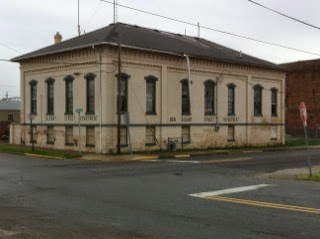Cluck cluck, plop? Plop, cluck cluck? Which came first, the chicken, or the egg? Which comes first, the private, or the public?
At the July 16th City Council meeting I found myself in a strange situation. I was voting against something at Council which I had previously voted for on the Redevelopment Commission. What brought about this change in thought?
First of all, my previous votes for the project were somewhat reluctant because it is such a big deal. And I have a persistent feeling that a project of this scale, in such a strategic position in our downtown -- that is, spatially, conceptually, and philosophically--deserves a higher level of study, input from citizens, and more in-depth consideration than a run of the mill ten-house development at the city's fringe.
We are told that this is a public/private partnership. We are given to believe that such deals are a wave of the future. As government is dismantled by the Tea Party set, it is these public/private partnerships which will get the job done, which will build our cities, toll our roads, define our path forward. As Pink Floyd assured us, "it's alright, we told you what to dream."
And as we arrived at crunch time, it hit me. This is the riddle we must solve. How do we, how does a government of the people, by the people, and for the people adjust to a pecking order where now it is often government of the corporation, by the corporation and for the corporation? Some will say, government and business should simply hold hands and let business guide us on the path to prosperity, civic rejuvenation, and a functional country, state, or city.
The presentation at the Council meeting the other night was informative and, frankly, resolved at least one of my concerns about the project relating to bankruptcies of the developer. I am not opposed to spending municipal funds on a definitional project of any scope which promises to make our city stronger, more sustainable, or more attractive as a place to live and work. I believe that is a valid function of government, but, I believe the use of public money entitles the public to a greater say in what those funds will buy. It would have been better, however, if such presentations had been held earlier in the process, and had been structured to include as many citizens' views as possible.
While the Chicken v. Egg case may never be fully adjudicated, it is the precedent used in explaining to me why we can have no final plans for the project. It goes something like this, "The developers don't want to spend
their money to get final plans ready only to have them pushed back across the table for revision, or even dismissal. They don't want to make those expenditures until they're certain the project is a GO."
Unspoken is the fear that getting the public involved might drag the process out inordinately, and cause the developer to spend money needlessly, or have the whole concept thrown out because of the adage that "too many cooks spoil the broth".
I'll admit either of those outcomes is possible. At the dawn of the Public-Private Partnership Era things might get a bit clunky, tedious, and frustrating if we continue to adhere to the old rules and old models. The Coyle project is not some two-bit subdivision. It is the future of this city. It requires a lot of public investment. New Albany is not a large city with an abundance of land to allow for a few misses, flubs and mistakes. This is one of the few large scale shots at something transformational in the downtown area. (This is not meant to minimize the exceptional work being done by several local entrepreneurs around town.) We need to hold the developer to the highest standard of design. We need a design with a long shelf life. We need to set the bar at the level
we want; not let the developer tell us what
they are going to do.
New Albany is committing as much as five million dollars to this project. Maybe it's a good project, maybe it could be better, but what's the final product going to look like? We don't know, because the developer hasn't told us if we will get a chicken or an egg.
We need new rules, special rules, to guide the use of public/private partnerships.
If we, as a community, or if the mayor and his team feel so strongly about the possibilities of a public/private partnership, let us
as a community finance the design we want the private developer to complete. This should allay reluctance on the part of the developer to present finished plans subject to revision at all stages of the project.
We are waiting now for historic review of the plans; we are waiting for the Plan Commission to weigh in. But decisions which might upend the project are made increasingly difficult to voice as we reach its expected - foregone - conclusion.
There's a nagging voice in my head that keeps saying something about "privatizing gain while socializing loss." A hopeful voice adds a third way, "democratizing vision".
If public/private partnerships are the new way, we need new rules and new expectations of how the private side of the partnership delivers the public good, and how the public's investment translates into the community's vision. I would much rather arrive at the disappointing conclusion we have spent some money on a proposal that won't happen, than to go "all in", at much greater cost, on a project that won't stand the test of time. Let public money pay for plans, and revisions that meet public goals. Let the developer handle the shovels and share his expertise. That looks like a better partnership to me.




